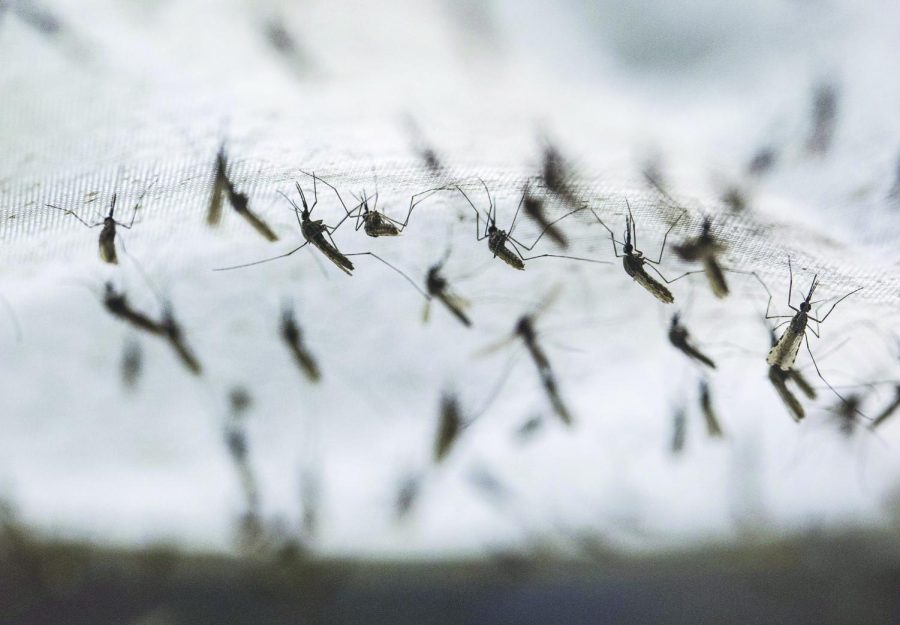Mosquitos test positive for West Nile virus in Kent
Mosquitoes raised at Seattle BioMed cling to fabric in a “bug dorm,” where volunteers place an arm during trials to receive up to 200 bites. (Steve Ringman/The Seattle Times/TNS)
September 22, 2015
The City of Kent Health Department is taking measures to rid the area of mosquitoes after seven mosquito pools tested positive for West Nile virus (WNV) – a jump from the three positive pools the city had last season.
“It was kind of the perfect summer for it,” Justin Smith, chief public health sanitarian for the City of Kent, said. “The history shows when we have a drought summer where there is very little rainfall, West Nile becomes more prevalent in the population.”
WNV was first identified in the Middle East and reached the eastern part of the U.S. in 1999, said Dr. Marguerite Erme, Summit County public health medical director. It’s a virus of birds – typically Blue Jays and Corvids – but it gets picked up and carried by mosquitoes. Humans contract the disease primarily through the bite of an infected female Culex pipiens mosquito.
When they transmit the virus to humans, Erme said a couple things can happen.
“One, nothing,” she said. “The person doesn’t get infected and doesn’t get sick. Second thing is the person might get infected, but has no symptoms whatsoever and may never even know that they were exposed to West Nile.”
70 to 80 percent of people infected show no symptoms, according to the Centers for Disease Control and Prevention.
Alternatively, a human may develop one of two diseases caused by WNV.
One is called West Nile Fever, Erme said, which is a milder disease where people get influenza-like symptoms that may occur three to five days after someone is bit, Erme said.
One in five people develop these symptoms of fatigue, body aches, joint pains, vomiting, diarrhea and a rash that takes weeks or months to recover from, according to the CDC.
The other disease humans may develop is West Nile neuroinvasive disease, which is a lot more serious and severe as it may affect the brain or spinal cord.
These people may have severe headaches, convulsions, seizures, weakness in limbs and paralysis. Some may die from this disease, but if they survive, they may have long-term complications or affects from it, Erme said.
The neuroinvasive disease is a lot more serious in people who are older, Erme said, and about 10 percent of people with the disease die from it.
Ohio saw its first death of 2015 by WNV in August in a 91-year-old Williams County man who was hospitalized with encephalitis, according to the Ohio Department of Health.
Summit County received its first human case of WNV of 2015 in August, but Terry Tuttle, Summit County Health District Division of Environmental Health supervisor, said he’s not surprised.
“It’s endemic here,” he said. “It’s been here since 2001, and it’s going to be here forever. I just like to hope, through spraying, hopefully we’ve saved some more human cases.”
The infected individual is currently recovering from the virus.
There are currently 19 human cases of WNV in Ohio.
// <![CDATA[ !function(e,t,i,n,r,d){function o(e,i,n,r){t[s].list.push({id:e,title:r,container:i,type:n})}var a=”script”,s=”InfogramEmbeds”,c=e.getElementsByTagName(a),l=c[0];if(/^/{2}/.test(i)&&0===t.location.protocol.indexOf(“file”)&&(i=”http:”+i),!t[s]){t[s]={script:i,list:[]};var m=e.createElement(a);m.async=1,m.src=i,l.parentNode.insertBefore(m,l)}t[s].add=o;var p=c[c.length-1],f=e.createElement(“div”);p.parentNode.insertBefore(f,p),t[s].add(n,f,r,d)}(document,window,”//e.infogr.am/js/dist/embed-loader-min.js”,”west_nile_2015_stats”,”interactive”,”West Nile 2015 Stats”); // ]]>
“I think people need to realize that mosquitoes are all over, and people travel a lot,” Erme said. “Looking at a person’s location may not necessarily be the site of infection.”
The City of Kent divides its territory into quadrants and sets four Gravid traps in each quadrant.
The Gravid trap is designed to catch the Culex pipien species and is simply a fan with a battery along with some rotting grass mixed with water.
On a normal night of trapping in Kent, Smith said they use eight traps — four in one quadrant, four in another — so they are able to catch half of the city’s mosquito population in one night. The following night, they trap the other half.
From there, the mosquitoes are counted, and the Culex pipiens species are put into a vial.
No more than 50 mosquitoes can be in a vial, which makes up a pool. These are then sent to the Ohio Department of Health, due to contract agreements, where they are tested for WNV.
This is only the second year Kent has been able to test mosquitoes due to funding. Last year, the city of Kent confirmed three positive pools.
Based on these results from the pools, as well as human cases of WNV, spikes in numbers caught in the traps, and complaints from residents, the health departments determine their spraying schedule. Additionally, Kent residents may request mosquito control services.
“We’re not going to spray pesticides unless we need to,” Tuttle said. “Since we’re a health department, we are concerned about disease to human beings, and that’s why we’re so heavily monitoring the West Nile virus.”
The number of mosquitoes carrying the virus varies each year, so it’s important to be prepared for a bad breakout season, Smith said.
And the season isn’t over yet. Mosquitoes are most active May through the end of September, or until the first frost.
In the case that you are bitten by a mosquito, Erme said to be cautious but not to be paranoid.
“Don’t look at every mosquito bite as possibly carrying West Nile because it doesn’t,” Erme said. “It’s not extremely common compared to a lot of other diseases we see, but people do need to be cautious because there are ways to prevent it.”
WNV is symptomatic, and there is no treatment or vaccine for humans. If you think you may have WNV, see your healthcare provider.
Lily Martis and Robert Carroll are city reporters for The Kent Stater. Contact them at l[email protected] and [email protected].












